

PopSci is spending September relearning how to eat. As intuitive as our love of chowing down is, a lot stands between us and optimal eating. This month, we’ll break down diet myths, unlock delicious kitchen hacks, and explore our most common misconceptions about our grub.
Cooking can be intimidating. There are so many potential ingredients, seasonings, and opportunities for things to go wrong—quickly. You could end up serving a meal that’s too spicy, too sweet, too salty, too sour, too bitter, or worst of all, so bland your guests aren’t sure if they actually ate anything at all.
Thankfully, cooking is a skill you can practice, and there are ways to reverse course if you notice your food starting to stray from what you had planned. The key is to taste your food as you go, as it’s much easier to adjust on the fly than it is to fix flavors when everything’s on the table.
The catch-all solution
When your flavor proportions go wrong, the easiest way to get them back on track is to add more of the other ingredients you’re already using. Tossing in more water, broth, potatoes, carrots, or whatever you’ve got on hand will even things out. Of course, you’ll end up with more food than you anticipated, but at least it’ll be palatable.
When you can’t—or don’t want to—add a hefty amount of additional ingredients, there are more nuanced solutions.
How to fix food that’s too spicy
Spice tolerance varies widely, so putting the right amount of heat into your food can be difficult, especially if you’re cooking for a group. Or maybe that cayenne poured out of the shaker just a little too fast. Your foe here is capsaicin, a chemical compound in chili peppers that irritates whatever tissue it touches. It might seem like a tough fight, but capsaicin can be beaten back in a number of ways.
In a similar vein to the catch-all solution above, you can serve the spicy portion of your meal with a more neutral food, such as rice, pasta, or bread. If you’ve ever eaten chili on a nice slab of fresh sourdough, you know it is *chef’s kiss* perfection.
Beyond that, consider mixing in some dairy. Milk, butter, yogurt, and the like contain a protein called casein, which attracts capsaicin molecules, gangs up on them, and hauls them away. Acids, such as vinegar and citrus, work too, as capsaicin is alkaline and adding acid can balance the pH.
You can also try adding something sweet like sugar or honey, or something oily, like tahini, peanut butter, or a neutral-flavored oil. Capsaicin is hydrophobic—it hates water—but it will hang out with oils, helping it chill out. The challenge with these solutions, however, is that you can easily add too much oil and turn your dinner into something that’s disgustingly slick, or sweeten a dish that’s not supposed to be sweet.
How to fix food that’s too sweet
Some savory dishes call for sweet ingredients, but too much sugar can ruin them. If you find your brown sugar glaze is tasting a bit too much like a caramel sauce better-suited for a towering ice cream sundae, you’ve got to act.
The same way sweetness can fight spice, a little bit of fire can counteract sweetness. Just be careful and taste, taste, taste—you don’t want to get caught in a sweet-spicy-sweet-spicy loop that doesn’t end until your guests start crying and order takeout (a worst-case scenario).
[Related: How to eat sweet foods on a healthy diet]
Sour and bitter ingredients will work too, though the former is a little easier to manage. Some lemon or lime juice can work wonders on a too-sweet plate, but don’t expect all citrus to work the same way. Orange juice will just make your problem worse by adding more sweetness to your sugary mess. Finessing a bit of bitterness is tricky because it’s difficult to find ingredients with the right proportions. Kale, for example, is bitter, but you’ll need to use a lot of it. You can also try unsweetened cocoa powder, but if you go overboard you might end up with a meal that’s weirdly chocolatey.
What you should not do is add salt, because this will only enhance the sweet flavor you want to diminish—salted caramel, anyone?
How to fix food that’s too salty
A little bit of salt can really amplify the flavors in both well-made and poorly-crafted dishes. But a lot of salt can ruin even the most gourmet fare.
If you’re cooking something that involves liquid, simply add more of that liquid to balance an overwhelming taste of salt. Water is often best because it’s neutral and won’t throw anything else awry, but if you’re careful you can use whatever’s already in the recipe. More milk in a creamy sauce, for example, will dilute the salt and make it creamier—a win-win. Just be wary of how much salt is in your liquid of choice already—salty broths or soy sauce can push the saltiness even higher.
Acid, like lemon and lime juice, can push back against salt too, and you probably won’t need much to get the job done.
There’s also a longstanding claim that adding a single raw potato to a salt bomb of a dish can sort the problem right out, but we don’t advise this unless you’ve already got potatoes in your recipe. Ultimately, it’s unclear how much salt a potato actually fights off. If you want to try, do so only as a last-ditch attempt to save your meal. And don’t forget to take it out before serving—a nice chicken alfredo served atop a big, honkin’, potentially semi-raw ‘tater is a bit… odd.
How to fix food that’s too sour
Cooking can be a delicate balancing act, and if you read the tips above instead of skipping straight here in a desperate attempt to solve your off-puttingly acidic meal, you already know sour ingredients such as lemon and lime juice are well-suited to counteracting sweetness. As with many of the other strategies listed here, this also works in reverse. Add some sugar, honey, or something else sweet to blunt the bite.
If you’re a little more daring, you can also try adding a bit of baking soda. This substance is basic, so it will neutralize the acid in your food and balance the pH. The risk, though, is that it tastes like salty soap on its own, so if you add too much you’ll create a whole new problem for yourself. It could alter the texture of your food, too.
[Related: There is a science to food pairing, and you can learn it here]
How to fix food that’s too bitter
You may not encounter bitter food often, but it’s a flavor that can make you push your plate away quickly. Whenever you find your concoctions are too bitter, think of coffee. Regardless of how you take it, this is a naturally bitter flavor many of us are familiar with, and there’s a reason people add sugar and cream: sweets and fats balance out the bitterness. Just do the same with your meal and you’ll be golden.
How to fix food that’s too bland
Got food that tastes like paper? Just add something to it. Salt is the easiest solution, as it enhances the flavors you already have going on. But you can also add sweetness, spice, acid, or whatever flavor you’re trying to make the focus of your dish. Let us taste something, anything.















